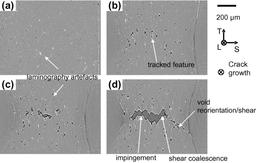Seminar 20th February 2012 noon Room 2001, Building 27
Fracture resistance of lightweight materials for transport: In–situ laminography and 3D crack path simulations
Dr Thilo F. Morgeneyer
Mines ParisTech, Centre des matériaux, France
- Web page
- http://www.mat.ensmp.fr/Pages/tmorgene/en_index.html
- Categories
- Materials
- Submitter
- Marcus Erridge
Sandwiches and drinks will be served from 11:45.
Please note that the Level 2 in Building 27 is not accessible via the RIfI entrance, but only from the side facing Chemistry or from Building 30
BIOGRAPHY: Dr. Thilo Morgeneyer is currently an associate research professor at the Centre des Matériaux, Mines ParisTech, France. He received his master's (double) degree from TU Braunschweig (Germany) and UT Compiegne (France) in Mechanical Engineering, and a PhD from the University of Southampton. His research and teaching focuses on the mechanics of materials. The research concerns in particular the fracture resistance of materials for transport and for energy production.
ABSTRACT: Synchrotron-radiation computed laminography (SRCL) allows for imaging at high resolution (~1?m) and in three dimensions objects that are thin (~1mm) but extended laterally in two dimensions. This represents a major advantage over computed tomography that can typically only investigate samples elongated in one direction. Here SRCL is used to observe ductile crack initiation and propagation in high strength aluminium alloy sheet for aerospace applications. Several load steps are applied and permit to follow the evolution of damage and crack path in-situ. Subsequently a feasibility study is made to obtain 3D displacement fields via a 3D digital volume correlation technique and derive strain fields in three dimensions. A performance study is carried out and initial results are given. Flat to slant crack transition is observed in this ductile thin sheet material. The crack initiates perpendicularly to the loading direction from the notch and then turns to 45° with respect to the loading direction during crack propagation. This phenomenon is, however, still not well understood and, so far, attempts to simulate the transition in three dimensions often fail to predict macroscopic loads correctly. In this study an initial attempt has been made to reproduce the flat to slant transition performing an implicit 3D Finite Element simulation via adapting a Gurson-type model. A second void nucleation term for deformation under shear was introduced. The Lode parameter was used here to identify shear deformation. Using this modification the flat to slant transition has been reproduced successfully at loads similar to the experimental results. Another example for the application of in-situ SRCL is given by an assessment of damage evolution in DP600 steel sheets for automotive application. These sheets contain industrially cut edges that are prone to failure during forming processes. Via in-situ observation the fracture mechanisms may be assessed and improved microstructures proposed.
Image: http://www.mat.ensmp.fr/Pages/tmorgene/en_index.html
